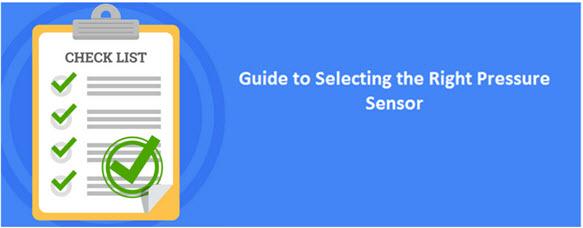Blog
An Unconventional Guide to Selecting the Right Pressure Sensor
An Unconventional Guide to Selecting the Right Pressure Sensor
September 14, 2018
Pressure is a factor that decides the fate of many equipment and, hence processes. Too much pressure can lead to accidents, whereas too less pressure can cause failure in proper functioning of many processes. Pressure sensor is used in a wide range of applications, which involve measuring the pressure of liquid or gas. The measured pressure can then be controlled or adjusted to carry out different processes. However, the selection of the right pressure sensor goes a long way in deciding the performance, and hence the throughput of the system. So, how do you know that the pressure sensor you are selecting is right for you? Well, there is a checklist to determine this. This post is intended to provide you a checklist or key factors to consider while selecting a pressure sensing device.

Checklist for Selecting the Right Pressure Sensor
The following is the checklist that you need to refer is you want to be sure that the pressure sensor that you is best suited for your application requirements:
1. What Is Your Application?
You need to understand what the intended application of the sensor is. There can be several applications, such as semiconductors, HVAC, vacuum sensing, engine testing, gas turbines, analyzing the performance of diesel engines, and so on. Different pressure sensors are required based on the application.
2. What Will Be The Pressure Range?
The second-most important factor that you cannot afford to ignore is the pressure range that is to be measured or controlled. While selecting a sensor, make sure that select the one, which has a larger pressure range than that required. This will give the necessary buffer for any spikes, pulsations, or transients.
3. What Is The Type Of Pressure To Be Measured?
There are different types of pressures that are measured in industries, such as absolute pressure, differential pressure, and gauge pressure. Now, only after identifying the type of pressure to be measured, you will be able to select the right sensor. This is because, the sensor technology that works well for one type of pressure might not work out fine for the other type.
4. What Output Signal Is Needed?
Output signal is another factor to consider, when it comes to selecting the right pressure sensor type. Based on their output characteristic, sensors are classified as high-level types (0-5 VDC, 0-10 VDC, 1-5VDC, and 4-20 mA) and low-level types (3 mV/V). So, depending on the required output characteristics, you should select the sensor.
5. What Is the Accuracy Required?
Last, but not the least, the accuracy required also plays a vital role in the selection process. Based on the accuracy desired, the cost of the sensor varies. As the required accuracy goes on increasing, the price of the sensor also increases.
By following all the points given in the checklist above, you can rest assured that the selected sensor is an apt choice for your requirement. Besides this, there are several experts in the field, who can guide you with the selection process. One such expert is the Transmitter Shop, which with its vast experience in delivering different types of pressure sensors and pressure transmitters. You can consider consulting experts from the company, who could be a valuable source of information for your pressure sensor requirements.
- Comparison between Multi Valve Manifolds Block Valves and Bleed Valves
- Understanding Electrochemical Detection: Principles, Techniques and Environmental Application
- How Can Greenhouse Gas Emissions Be Reduced?
- Pneumatic Pressure Controllers: A Safe Choice for Hazardous Areas
- A Practical Guide to Vacuum Measurement and Operation
- Understanding Electrochemical Detection: Principles, Techniques and Environmental Application
- How Can Greenhouse Gas Emissions Be Reduced?
- Pneumatic Pressure Controllers: A Safe Choice for Hazardous Areas
- A Practical Guide to Vacuum Measurement and Operation
- An Unconventional Guide to Selecting the Right Pressure Sensor
QUICK ENQUIRY